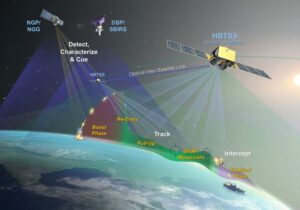The Missile Defense Agency (MDA) expects the first flight test using a pair of prototype space-based hypersonic sensors to occur within a week while also starting to look at a new airborne laser program.
“We’re getting ready for our first hypersonic testbed calibration flight within a week, where we are going to take a hypersonic test bed target and launch that and, for the first time, have both of those sensors tracking and looking to see how they’re doing and how they could potentially close the fire control loop,” MDA Director Air Force Lt. Gen. Heath Collins said during a June 6 event at the Center for Strategic and International Studies.

The Defense Department launched the two prototype Hypersonic and Ballistic Tracking Space Sensor satellites (HBTSS) in February (Defense Daily, Feb. 14).
He said MDA is planning to conduct a second HBTSS test bed launch later this year and these are “key steps in our ability to prove out that we can close a hypersonic fire control loop from space, key to the future.”
Collins underscored MDA is working well with the Space Development Agency to ultimately deploy more space-based hypersonic missile sensors.
He said MDA is “in lockstep” with the Space Development Agency as they are planning more HBTSS-like sensors in their future tranches of the proliferated warfighting space architecture “to start to fill out that truly global, hypersonic kill chain for us. And so that’s a pretty bright future for us, so to speak, as we move forward.”
Separately, Collins admitted MDA is looking at airborne laser systems again after the Pentagon took directed energy programs out from MDA in recent years. The FY 2025 budget request notes the MDA is looking at investing $11 million into airborne laser technology.
“Directed energy has come a ways…for a number of years back we stepped away a little bit and the Department took over a broader set of directed energy investments in S&T activities. We now see that getting into a level of not just power, but also the overall size and weight of the lasers, whereby we do see a future,” he said.
The director said MDA had an independent team take a look at directed energy advancements and “they’ve recommended that there’s some things that we could do.”
Collins confirmed this renewed funding “is the beginning into a foray back into an airborne level of directed energy.”
MDA is planning to start with the tracking characterization side, but “then the technology ramp that we’re seeing, as that comes to fruition, we will continue then to look at maybe potential lethal effects of directed energy as we go forward.”